World of Birds: A Conversation with Christine Sheppard, Retired Curator of Ornithology at the Bronx
- Grayson Ponti
- Apr 1, 2018
- 12 min read
For decades, Christine Sheppard was part of the legendary team of zoo professionals at the Wildlife Conservation Society's Bronx Zoo. She spent most of this time as Curator of Ornithology, where she was responsible for managing one of the largest bird collections at any zoo in the world. Sheppard and her staff accomplished many advancements in bird husbandry, reproduction and research. Here is her story.

@ Christine Sheppard
Prior to coming to the Bronx Zoo, Christine Sheppard completed her PhD with Dr. Tom Cade, who used captive breeding and falconry to reintroduce the peregrine falcon, which had become extinct on the East Coast. “I became interested in captive breeding of endangered species and zoos were just starting to call themselves arks,” she recalled. “I contacted a bunch of zoos who either said I was overeducated to be a keeper and underqualified to be a curator. The Bronx Zoo got a grant for curatorial interns. I applied and got the one for birds.” In 1979, Sheppard joined the staff of the Bronx Zoo, where she would spend the next three decades.
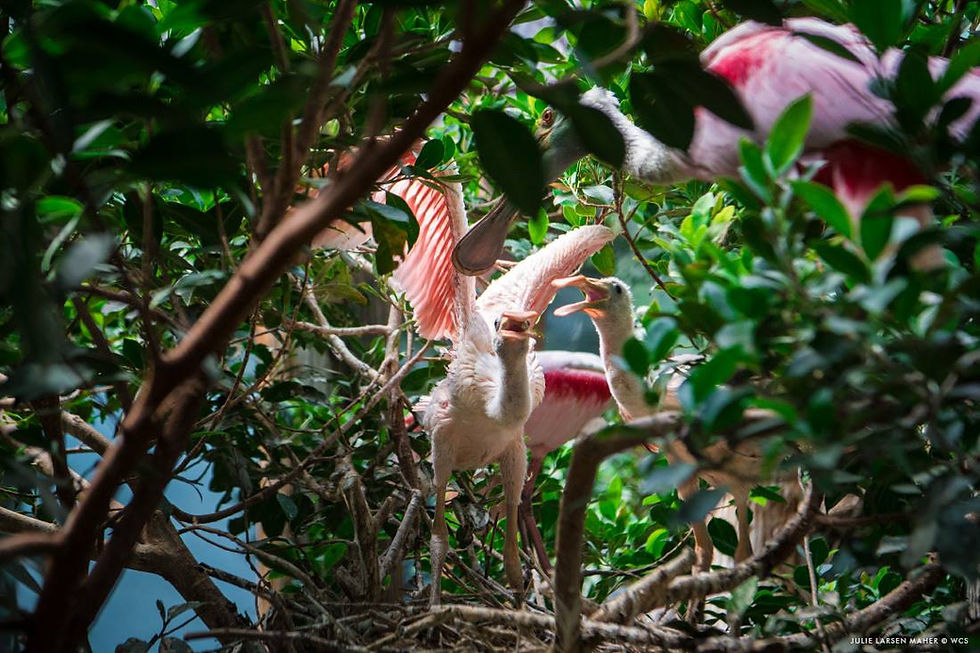
Julie Larsen Maher @ WCS
Unlike most curators at the time, Sheppard never worked as a keeper. “The Bronx Zoo was big enough it could afford to hire someone who didn’t know much but had a scientific background as the departments had multiple curators,” she explained. “I didn’t start as a keeper and go through the ranks.” Joe Bell and Don Bruning were the bird curators and they gave Sheppard a variety of tasks. “Don started having me work in the different instillations and do inventories on signage,” she stated. “then I was assigned to figure out why we weren’t breeding waterfowl the way they thought we should be. It turned out we mostly had males. That led to me going to a duck farm on Long Island where they took me to the slaughterhouse and tried to see if I would faint.” Through Bruning and Bell, as well as supervisors Andy Winnegar and Gus Waltz, Sheppard learned the practical side of bird management and husbandry.

Julie Larsen Maher @ WCS
The Director of the Bronx Zoo was Bill Conway, who had been Curator of Birds prior to becoming Director. “Conway really thought of himself as Curator of Birds,” Sheppard remarked. “He was proud of being a bird person. I remember [his reaction when I] told him I’d been a bird curator longer than he had.” Conway broke ground in terms of exhibiting birds when he designed the Aquatic Bird House and World of Birds prior to Sheppard’s arrival, which featured naturalistic, open environments for birds true to their natural habitats. “I began to realize what Conway respected was if you’d go in to talk to him with your ducks in a row,” she noted. “Conway knew so much about birds so you had to say what you were going to do and why.”

@ WCS
Sheppard became established at a time in the zoo world when the way zoos got their animals became radically different. “By the time I got there, there had started to be quarantine requirements and importation restrictions,” she added. “Things were moving in the direction of naturalistic exhibits, propagation and collaborative programs.” With species becoming rarer and harder to obtain in the wild, zoo leaders created Species Survival Plans (SSPs), breeding programs aimed at creating sustainable populations in zoos. “I was one of the people who helped invent TAGs,” Sheppard elaborated. “AZA had created a list of the first ten species to work on and white-naped cranes and Andean condors were two in the collection at the Bronx Zoo. I had started as studbook keeper for white-naped cranes. Then, I went to all these population management workshops and started to realize there were half a dozen of use on all the crane SSP committees. We decided to start meeting together, and too look at how much space there was for cranes in AZA zoos, wo we could determine how many SSPs could realistically coexist. There are twice as many bird species as mammal species, but at that time, relatively few bird curators, so we knew we needed to work together.”

@ WCS
A year and a half after coming to the Bronx Zoo, Sheppard was promoted to Assistant Curator of Ornithology. One early interest was bird nutrition. “I actually invented my own computer program to do diet analysis and find out what we were feeding the birds and look at improving them,” Sheppard remarked. “What birds like to eat isn’t always balanced or good for them, but many balanced diets weren’t palatable, so we tried to combine good nutrition with palatability and developed a guideline for 20% of calories as management food. I tried to develop diets for newly hatched birds and developed protocols for raising all kinds of species like pink pigeons and African pygmy geese.” Sheppard would eventually become Curator of Ornithology.
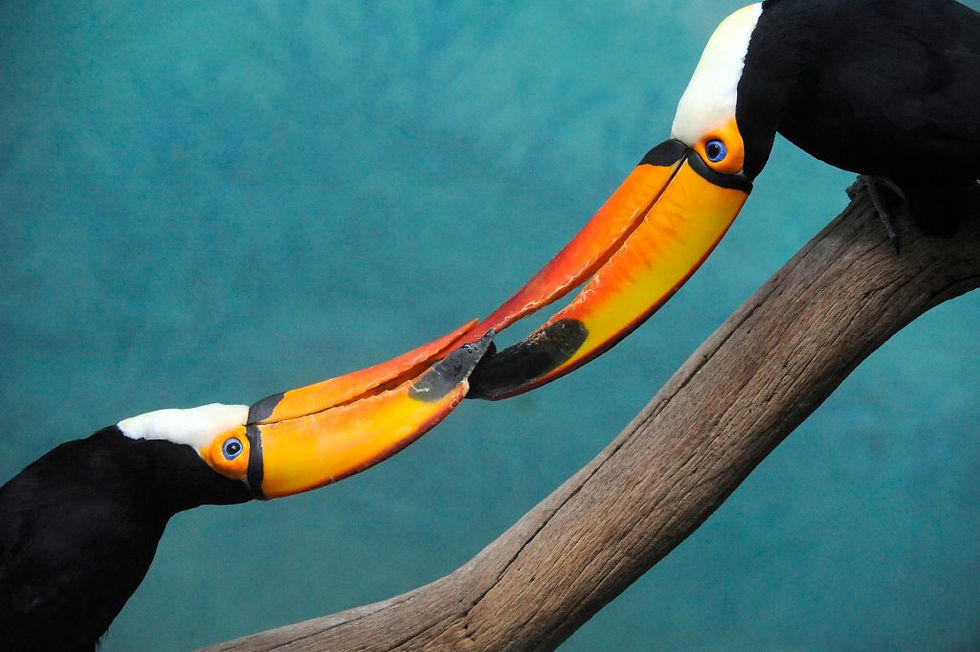
@ WCS

@ WCS
Since Bruning spent a lot of time in the field, Sheppard became increasingly responsible for the day-to-day management of the bird department. “For a long time, I was the person who had flexible responsibilities,” she reflected. “Having a PhD and not knowing anything meant I had a lot to learn, but gave me a lot of leeway. I began to realize if we were ever going to achieve our potential, we had to empower the keeper staff. Instead of them being the people who just cleaned cages and fed animals, they needed to be partners in all the projects we were starting to do. It took a long, long time for the keeper job to move from a janitorial one to a conservation professional, but I’m very proud we helped that happen. We started producing people who could go from bird keepers here to supervisors and general curators at other zoos. We created a whole ‘old bird network.’”
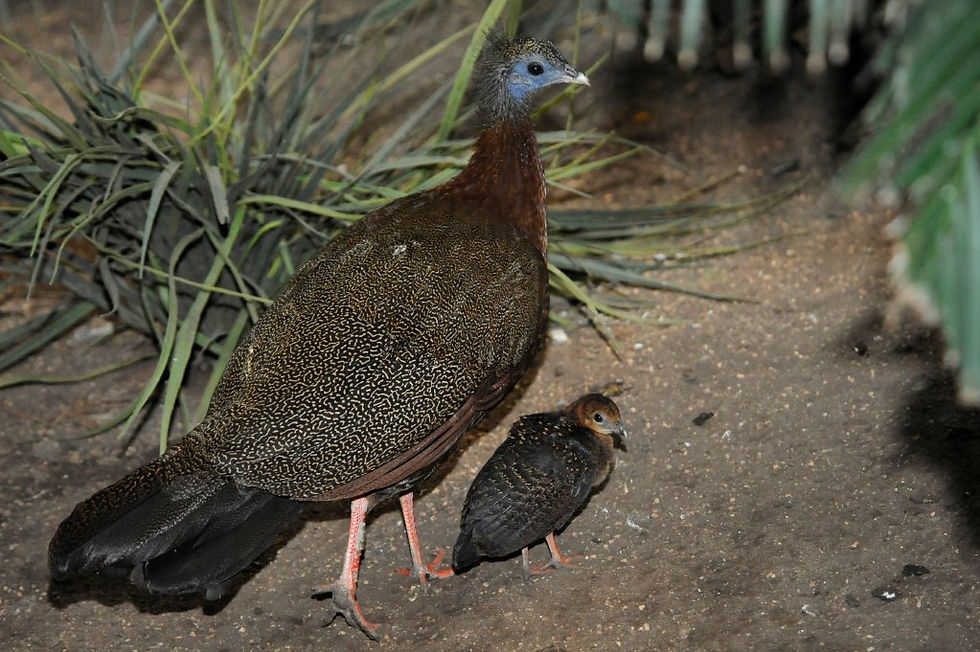
@ WCS
Sheppard became a specialist in white-naped cranes. “White-naped cranes are incredibly beautiful animals,” she elaborated. “When I first started, the idea was, if you work with an endangered species, breed as many as you possibly can. We pulled eggs to hand-raise and get six cranes instead of just one. We did a lot of work with hand-raising and exercising birds so their legs didn’t bow. I did a project on eggs to better understand what goes on under a bird and why we tend to hatch one species of crane better one year than another. My personal opinion became I’d rather have one parent-reared chick than three hand-raised chicks [as they behave more naturally.]”
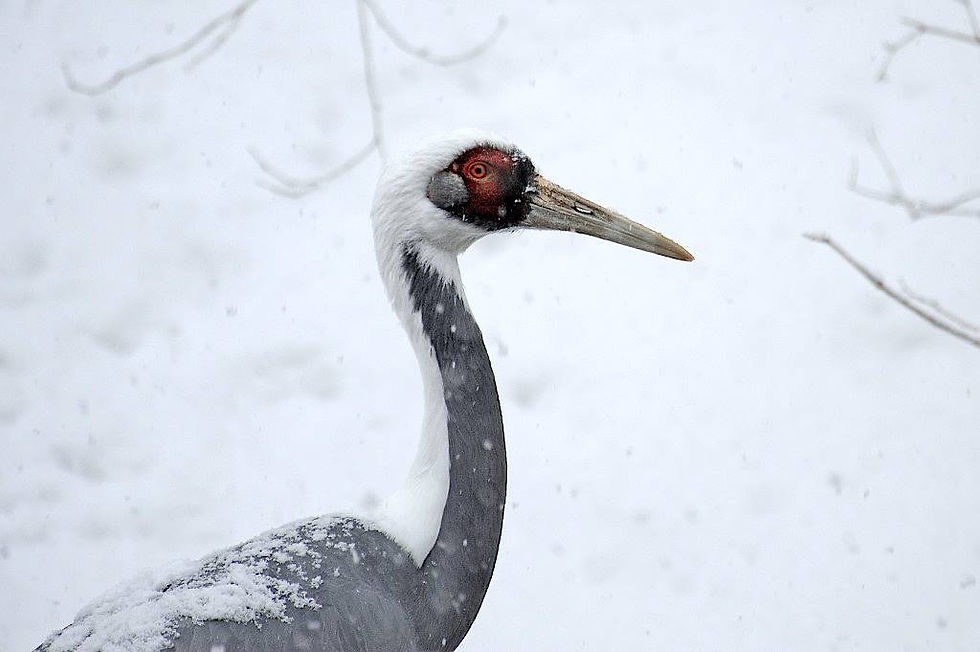
Julie Larsen Maher @ WCS
Among Sheppard’s personal favorites were flamingos. “I love flamingos,” she stated. “A couple years after I got there, it was decided, since we had small numbers of Andean, James and lesser flamingos, we’d send them off to Britain. Then, as soon as we made that decision, two of the lesser flamingo pairs hatched a chick. We still sent them to join larger breeding groups and continued to keep Chilean flamingos at the Aquatic Bird House. After the old waterfowl pond near the café was done, we gave it to American flamingos.”
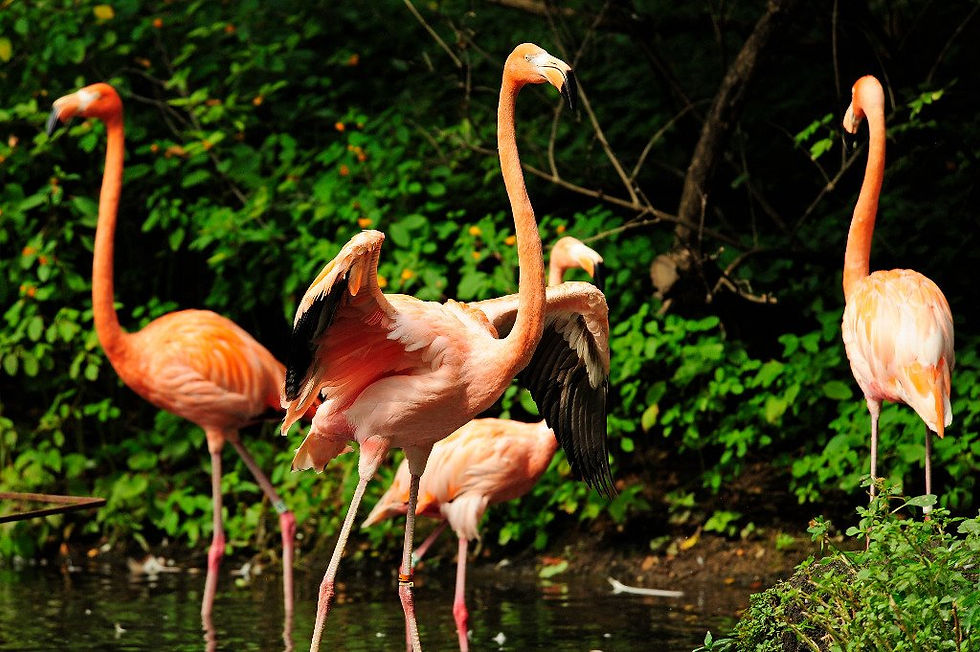
@ WCS
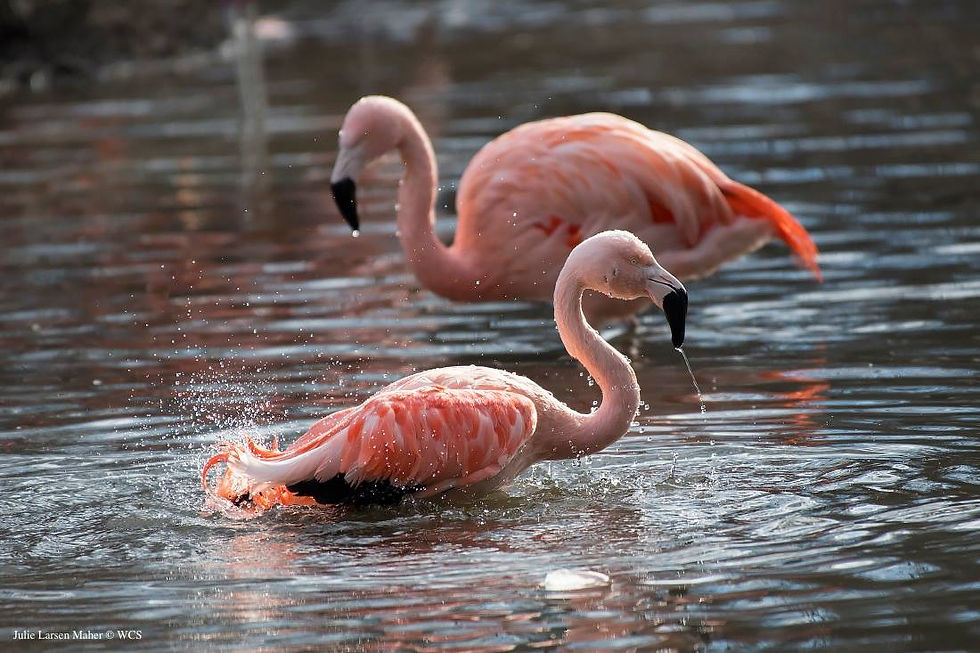
Julie Larsen Maher @ WCS
“Flamingos are very interesting,” Sheppard continued. “It turned out we could do a lot more active management with flamingos than we thought. We could train them to come in at night and, if there’s ice, they’ll stay in the shelter.”

Julie Larsen Maher @ WCS
Flamingo breeding turned out to be quite unpredictable. “Flamingos will breed if they want to,” Sheppard explained. “We’d craft crude mounds of mud, because flamingos often used remnants of nests from previous years but could never establish why they nested in one year but not another. When we moved them behind World of Birds to do construction on their holding building, we were sure they wouldn’t breed but they all bred. At conferences, groups of curators would meet formally, or in the bar and decide on new strategies. We tried bringing in new birds, moving birds, playing vocalizations, simulating rain and more to stimulate their breeding but there was no magic trick. Flamingos are fabulous but you have no clue what motivates them.”

Julie Larsen Maher @ WCS
Many of the Bronx Zoo’s birds were housed in World of Birds, built in 1972. “I was involved with the major renovation of World of Birds and, in some ways, we tried to make it more like Aquatic [Bird House],” Sheppard recalled. “World of Birds used to be quite a formal building with a handrail in front of each exhibit. We wanted to give people more of a sense of connecting with the birds and have it be less like a museum diorama and more something you were a part of. We brought the habitats out. We found people arrived at the zoo looking for the tigers and kangaroos but on the way out would say the birds were one of the things they liked best.”

Julie Larsen Maher @ WCS
In 1985, the Bronx Zoo opened Jungle World, a groundbreaking indoor Southeast Asian rainforest. The building would feature several free-roaming bird species. “They wanted to have birds in most of the exhibits in Jungle World but it was a battle as to where to have the holding spaces for the birds,” Sheppard recalled. “For awhile, you had to get into a classroom, go out a window into a planter and go up a ladder to get to bird holding space. For another one, you had to go through a crawl space and on to a pergola to feed the birds. You had to improvise a lot and say here is a space we could do something with.”
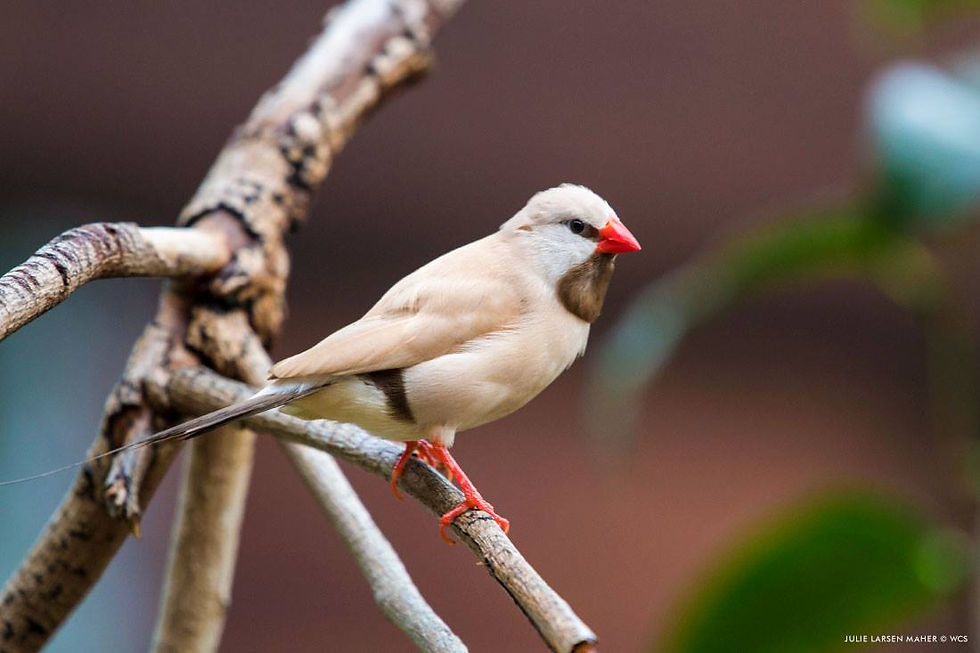
Julie Larsen Maher @ WCS
Careful thought was put into selecting which birds would be in Jungle World. “We had to think about what was going to work in Jungle World,” Sheppard noted. “You needed big showy species that like to sit out on an open perch. Red-billed blue margies work very well while tir-tufted barbets and leafbirds would be practically invisible. You had to be constantly on your toes to figure out how to make something inaccessible to dangerous creatures.”

Julie Larsen Maher @ WCS
A very difficult bird species to work with was maleo. “I really loved working with maleo,” Sheppard recalled. “It was one of the most challenging species around. They’re megapode; the adults, dig pits in volcanic sands in Indonesia, go back into the woods and leave the chicks to hatch on their own.” Very few maleos lived in American zoos. “San Diego had two and we had two,” Sheppard said. “All four of those birds eventually went to St. Catherine’s Island (the Bronx Zoo’s former off-site breeding facility in Georgia.) When we stopped working at St. Catherine’s, we brought them back to Bronx and had to figure out how to house them and create heated sand for them to dig in a much colder climate.”

Public Domain
“I also had a lot of fun with lesser adjutant storks from Cambodia,” Sheppard mentioned. “I love hornbills and bee-eaters. We had to work a lot on figuring out the diet and sand needed to breed bee-eaters. We had bee hives on the roof so we had bees to feed the bee eaters. I really enjoyed working with everybody to figure this stuff out.”

Public Domain
For decades, the Bronx Zoo bred a wide variety of birds and other animals on St. Catherine’s Island in George. “St. Catherine’s is a barrier island off the coast of Savanna,” Sheppard described. “It belongs to the Nobel Family and one of our trustees was a bird lover [so we bred a lot of birds there.] The idea back in those days was there would be a number of places to have off-exhibit space to do stuff you couldn’t do on exhibit, because visitors don’t want to see five pairs of the same species. We focused on hornbills, parrots and cranes. There were a number of hoofstock, lemurs, tortoises and other animals too.” The breeding facility at St. Catherine’s closed in 2004.

@ WCS
Sheppard helped strengthen communication and networking in the bird community. “We really started realizing we needed to work together and it was hard to do that unless people went to meetings,” she said. “We had all the bird programs meet at one of the AZA regional meetings. We started ASAG so we could really involve everybody. We encouraged zoos without bird curators to create positions.”
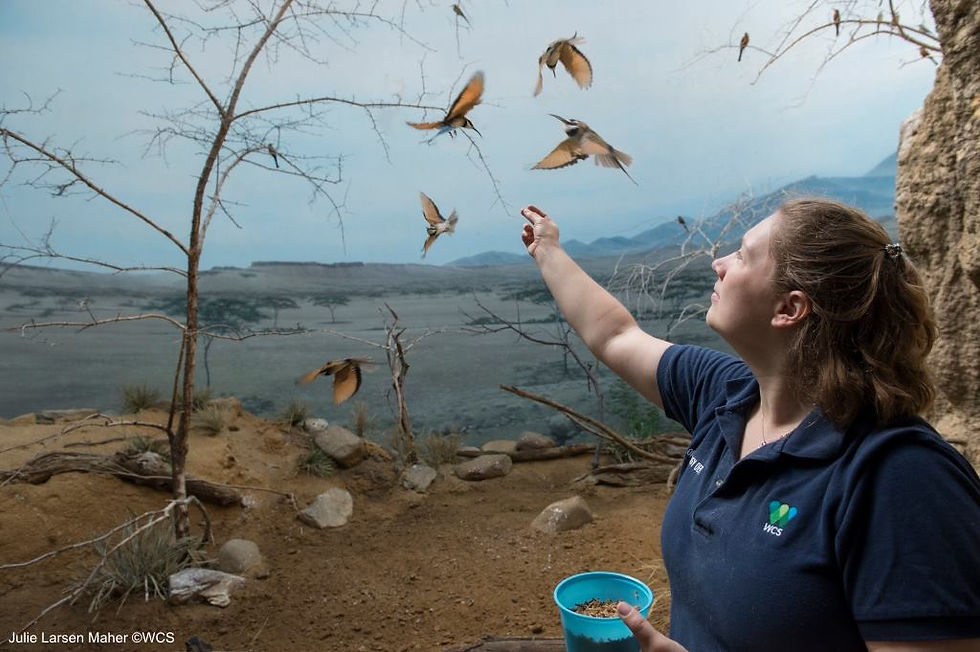
Julie Larsen Maher @ WCS
For awhile, Sheppard led the gruidae Taxon Advisory Group (TAG), managing the genetic breeding populations of cranes in zoos. It determined which crane species zoos would focus on. “We started the crane group as we were going to workshops where we were taught to manage stuff,” Sheppard elaborated. “We knew the minimum size group we could have with cranes could tell us how many species we should work with. You want to be able to save everything but you have to factor in exhibit space. Also, animals have personalities and the ones that genetically match [might not get along.]” In some cases, SSPs were controversial with staff. “Some of the moves were unpopular as we’d break up animals that had been together for a long time and it’s hard not to project human emotions,” Sheppard explained.
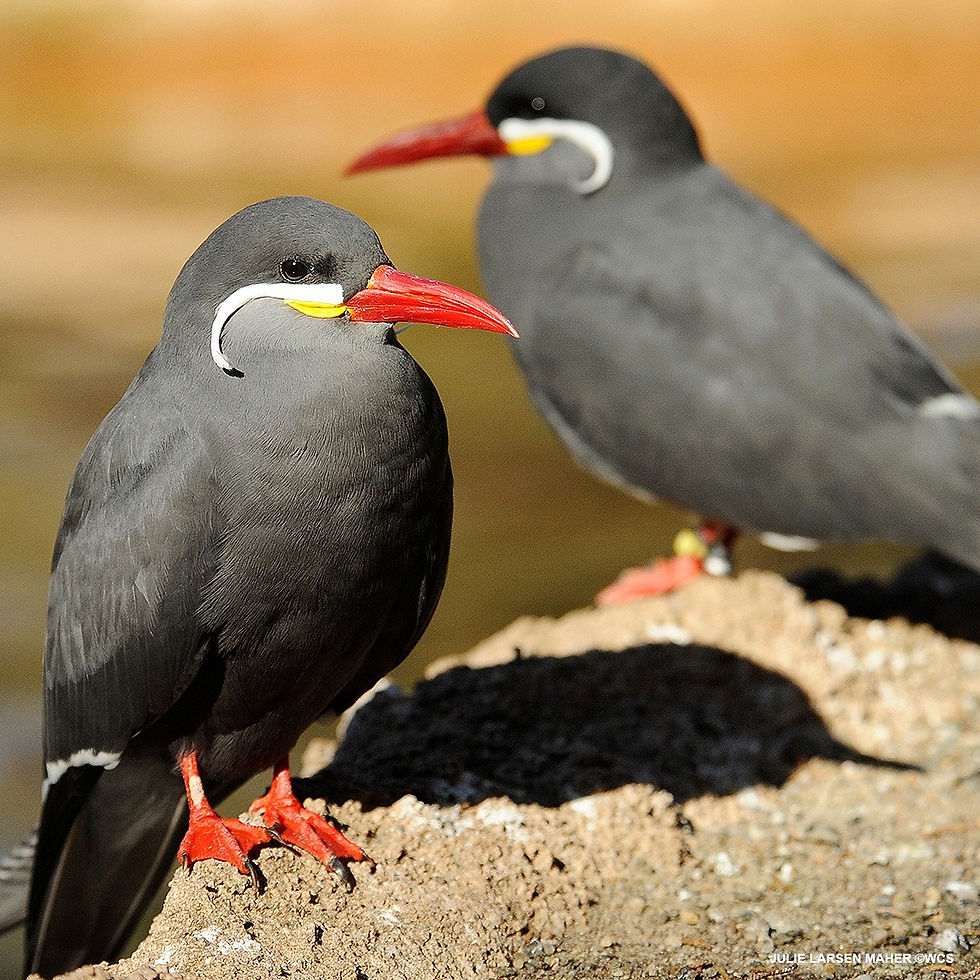
Julie Larsen Maher @ WCS
Sheppard ended up handing over the gruidae TAG as “I realized a lot of people wanted to work with cranes.” Instead, she took over the TAG for hornbills, kingfishers and bee-eaters. “It was hard to manage genetics in species that breed in flocks,” Sheppard mentioned.
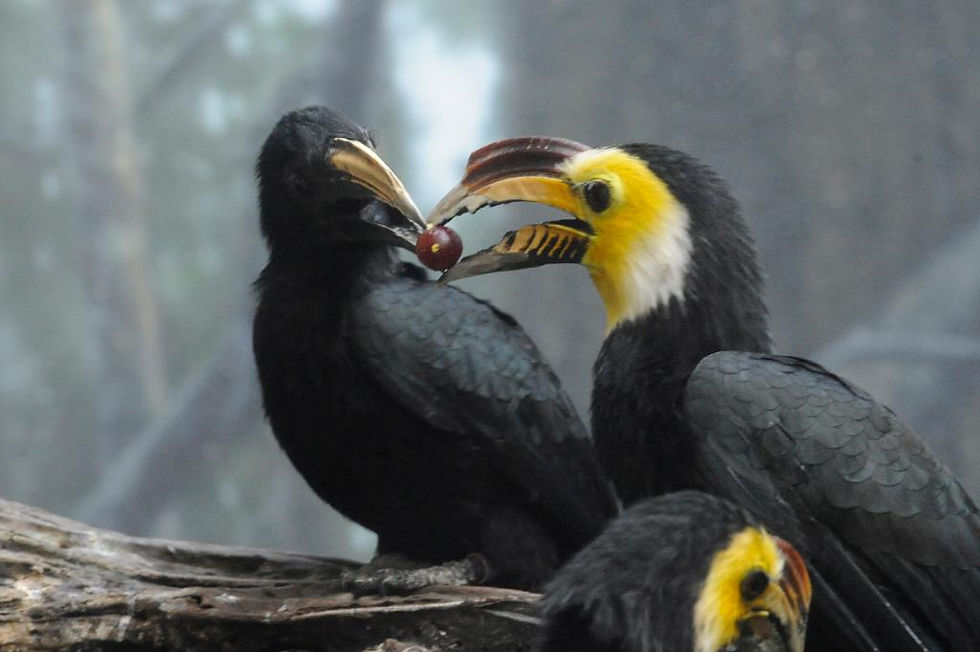
@ WCS
A conflict in SSPs and TAGs was the debate between prioritizing genetic diversity or numbers. “I think if you only have two birds, you should breed as many as possible and not worry about genetics,” Sheppard expressed. “It’s like they’re the only two anybody has so are you just going to quit? In cases like that, you want to maximize genetic diversity but you have to go with what you have. Tom cade, my major professor at Cornell who inspired my interest in captive breeding, wanted to restore Peregrine falcons to the East Coast, where DDT had caused them to become extinct. There were no individuals from the eastern subspecies available, so the breeding program mixed individuals from other subspecies and their offspring were released and have established breeding populations. these birds were released in urban areas, where tall building evoke their preferred nesting sites and pigeons provide a good food source, so the habitat was quite different. It would be interesting to compare their genetic profile with the original east coast subspecies.”

@ WCS
In the winter of 1995, the Bronx Zoo’s historic flight cage collapsed in a snow storm. “The flight cage was originally built in 1899 and was basically a piece of the park enclosed by a series of iron hoops,” Sheppard remembered. “The habitat inside was completely renovated in 1980 into a piece of Patagonia featuring Magellanic penguins, a species WCS also worked with in Argentina. We transformed it into a pool with a central island and cliffs that looked a lot like Patagonia. In 1995, there was a heavy wet snow and one of the iron hoops supporting the wire mesh enclosure just popped from the weight, bringing down the next until the whole center of it went kur-plop. I was at home and had to get my car through the snow to the zoo. Luckily, the Inca turns were mostly inside and the penguins were fine but we had gulls fly away. We had people start calling the zoo saying they’d found tour birds but they generally turned out to be pigeons- people didn’t realize there were birds everywhere.”

Julie Larsen Maher @ WCS
It was decided to rebuilt the area, keeping its as Sea Bird Colony and it reopened in 1997. “We redesigned it to make it bigger, airier and not have structural stuff inside,” Sheppard remarked. “There were kids at a local school that collected change to help us restore [the exhibit.] It was a wonderful experience to walk through there and have birds fly around. The terns could actually wheel as a flock. The penguins could swim in a circle and porpoise.”
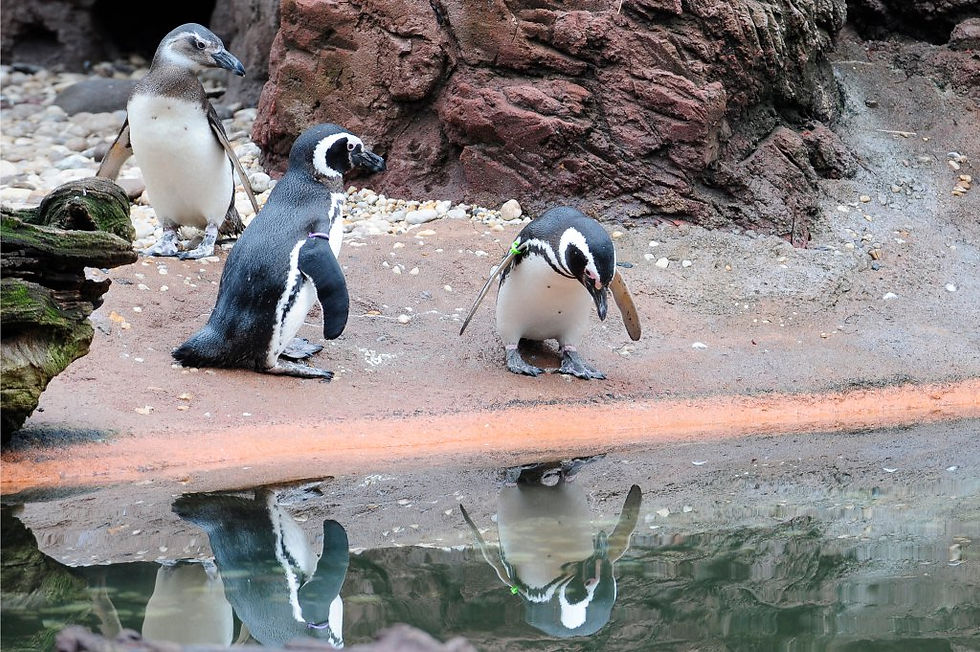
@ WCS
In addition to spaces for birds, Sheppard made sure to improve facilities for keepers throughout the bird areas. “We did things like add windows, stainless steel irons and a title floor to an existing kitchen,” she said. “I was really proud of giving people the tools they needed to do a good job and the time they needed to do a good job. The number of birds per keeper is much higher than the number of mammals per keeper. We were looking for suggestions like the one a keeper made to create feeding areas with surfaces easy to hose and keep clean. [We concentrated on] basic day-to-day things that make a huge difference in doing the job.”

@ WCS
In 2009, Sheppard retired as Curator of Ornithology at the Bronx Zoo. “In 2008, the economy tanked and [WCS] did one of those staff buyout things,” she remembered. “I had been there for thirty years and it was an offer I couldn’t refuse. I thought I’d retire, set up a nonprofit and work on bird collisions. Then, the American Bird Conservancy (or ABC) had that job available.”

Julie Larsen Maher @ WCS
Since that time, Sheppard has worked with the Bird Conservancy to protect birds, often partnering with zoos and aquariums. “Bird collisions is something someone can hear about and do something about in the same day - you can fix your windows,” she explained. “It is a great message that AZA institutions can provide to their guests. Feral cats and glass are killing billions of birds ever year and there’s no excuse for that to continue. Cats should be licensed like dogs and new structures should incorporate bird-friendly design strategies.”
“I really think I was part of helping zoos become conservation organizations as opposed to simply places for people to stare at animals,” Sheppard concluded with pride. “People need birds more than they realize and zoos are one way to get people to understand that. Birds really help make people happy.”







Comments